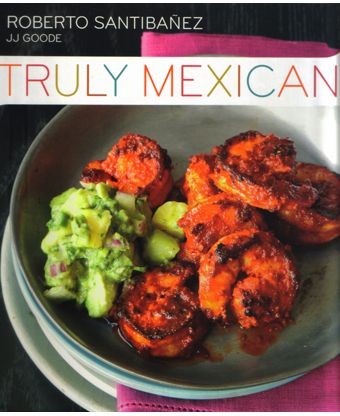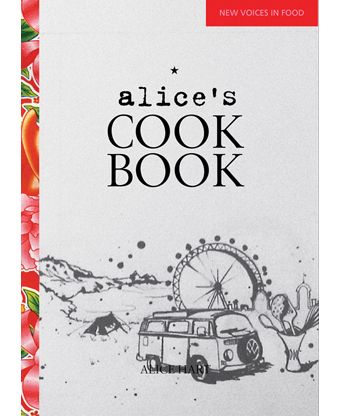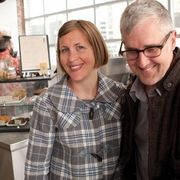Not being a professional writer, or a chef, for that matter, I'm entering this project of reviewing a cookbook with a lot of trepidation. The trepidation is even more intense considering the ironic circumstances I'm placed in: I really need to finish writing a cookbook. Caitlin and I have escaped to Cayucos, California, a charming, sleepy beach town ambiguously located in neither southern nor northern California, far enough away from our daily lives, and with poor enough cell reception that we think staying in her deceased grandparents' bungalow will make for an ideal interruption-free writers' retreat. We're here for the better part of a week with the ostensive purpose of finishing this goddamn book about growing coffee, roasting coffee, serving coffee, and making food that goes really well with coffee whose manuscript, as our editor is so fond of grimly reminding us, is due on Caitlin's birthday. It's not a surprise, this deadline, but it has caused me to discover that there are so many ways not to write. Including judging cookbook competitions. That's why, in spite of our there-but-for-the-grace-of-god-go-I position as future cookbook authors sweating their first reviews, we so eagerly accepted the assignment. Also because Charlotte asked. And it's tough to say no to Charlotte.
The division of labor is thus: Caitlin peruses the cookbooks, shops, cooks, and slides practical and succinct comments in between my blocky and digressive paragraphs. I tap away on my laptop, occasionally working on the book I'm supposed to be working on, make coffee, drink coffee, ask probing questions like "does that font look like Gotham or Futura?" and attempt to summarize our feelings about these books and the food we've eaten from them. Which is to say: write this essay.
Each book considered as an object of desire, curiosity, or repugnance
Alice’s Cookbook
James: The general color palette of the book is an appealingly feminine grey, celadon, and steely Nordic white. That palette is unfortunately betrayed by an over-avuncular approach to typography which ranges from athletic all-caps Times New Roman manifestos in 24-point type, to demure italicized headnotes more or less beseeching us to ignore any part of the following recipe we might find inconvenient, to chapter headings in a Gotham-y grey on celadon, which, in spite of the “you can trust me, I’m Gotham” vibe of the font, gives out curiously un-emphatic advice like “Rhubarb soufflés are not at all difficult to make.”
The photography is shot in what I’m calling “pre-ImClone Martha.” A lot of vintage linen tea towels, flea-market looking pewter dishes, crumbs, twine, and attractively peeling paint. The photos are, strictly speaking, unnecessary to the preparation of any dish – no process shots, and the dishes themselves are so simple that not to a have a photo of the finished product is not going to confuse anyone. The photos are refreshingly free from making the author the center of attention — just a few MFL (My Fabulous Life) shots on the back cover, and the rest is food. While there are not very many photos (I’m fine with that), they do an admirable job of hewing to the palette of the rest of the book.
Caitlin: Digging into the recipes, I began to sense that I fundamentally didn’t want what this book was selling. I understand that there is an industry of how-to guides on looking beautiful and calm while hosting a gathering of fabulous friends in a beautiful house. But my reality is that the kitchen is my workplace, and when faced with a crowd of houseguests in the kitchen, I find myself barking “corner!” and “hot pan!” and rudely shooing them out. I know that I’m just the sort of project that Alice is looking to tackle in this book, but I’d rather just make a reservation for 6, and let someone else stress about feeding a crowd.
Truly Mexican
James: Santibañez’s blurbs, while not without charm, have a certain “just the facts, ma’am” journalistic straightforwardness that I can at least feel informed by. I know where his restaurants are, and how long they’ve been open. There’s nothing tricky, or grandiose, or cringingly ingratiating. I’m relieved. I can just look at the recipes.
The palette of the recipes follows the cover, with a slightly too-tricky code: total cooking times are printed in aquamarine, active cooking times in burnt orange, yields in aubergine, and the Spanish-language name for the dish in umber with a rustic south-of-the-border all cap cactus-y serif font. The head notes and the recipe instructions are in the same handsome, sans-serif font from the cover, the ingredients are printed in an oddly-compressed gargoyle serif bold, and the end notes (what you can do with the sauce, how long the dish keeps, etc) are printed in a lighter version of the ingredient font. As opposed to Alice’s Cookbook with its meandering permissive-parent approach to the layout of the book, I appreciated the consistency and Marlboro-man reliability of the recipe layout of Truly Mexican. After looking at a few recipes, I knew what to do, and if you’re treating your cookbook like a tool, then what else do you need?
The photography of Truly Mexican also falls into the lifestyle category. There are a few process shots, a few shots of roasted peppers that might be helpful if we’re afraid of burning anything, but for the most part, they match the pulsingly over-vibrant and corny mid nineties food mag aesthetic set all too well by the cover shot. So much stoneware and cast iron, artful and self-conscious messes next to perfectly composed plates, it’s as though there were a contest in which a Mexican cookbook had to be easily distinguishable from an Italian cookbook from a distance of twenty feet. Santibañez wins.
Caitlin: Looking through this book, I began to feel panicky about how I might possibly put together dinner. Each meal would require 3-4 different recipes, and there wasn’t a clear guide to help me narrow down which adobo I should pair with which meat, which guacamole was the one on the cover, or whether or not I actually needed guacamole for our dinner. I was intimidated by the ingredients and freaked out by the need for multiple recipes to complete one meal — and the fact that every part of it was out of my cooking comfort zone.
Cooking and eating
Alice’s Cookbook
James: Caitlin chose four recipes — breakfast and dinner: Apple and Almond Muesli; Buttery Apple, Honey and Polenta Loaf Cake; Giant Yorkshire Pudding; and Slow-cooked Pork, Apples, and Caraway.
Every time Caitlin and I end up in a not too spectacular European hotel basement breakfast buffet, jet lagged, and looking helplessly for the spoons, I wonder about muesli. "Uncooked oats" I think to myself. "Why is that so great?" I feel like a vulgarian, but I just don't get muesli, and I assume that if I were more European, somehow, that if I drove a 6 speed manual- transmission diesel, had rectangular glasses, or took August off, that I would understand, and presumably appreciate uncooked oats. But Alice has cracked the code. Her genius idea of soaking the oats overnight in apple juice uses the acidity of the apple juice to "cook" the oats, in much the same way that lemon juice cooks raw fish, creating a sort of oat ceviche by the next morning. Adding nuts, honey and grated apples creates one of those perfect European moments of culinary self deception, wherein we manage to convince ourselves that something delicious and absolutely packed with fat and calories is actually good for us, and that we should strongly consider eating it more often. And take August off.
Speaking of fat and calories, the giant Yorkshire pudding, which accompanied our stew the evening after our delightful muesli, was a sodden mess. Sure, it was warm and fatty and puffy, but it cooled off fast, and cold it was a little like seeing a deflated volleyball on our plate.
Apples, pork and caraway are three of my favorite things to eat, so I had high hopes when the stew came out. But it was grey! Curiously, the italicized head notes to the recipe say “you can use all stock instead of a stock and cider mixture if you wish.” These notes are peppered throughout the book. They got under my skin like a guitar-store noodler playing “Stairway to Heaven.”
I know I can use all stock instead of cider, but which is more delicious? The whole point of buying a cookbook is to have an expert show me the path. I don’t want breezy permission in print to follow my bliss. I am paying for constraints and expert advice.
“I’m not a fan of nuts in my brownies, but don’t let that stop you from throwing in a handful of chopped pecans or walnuts”
“If the recipe below seems like too much work, just follow the first paragraph to prepare plain basmati rice.”
“Leaving the bacon out will make this vegetarian friendly.”
Caitlin: Looking for something not “meant for a crowd”, the first recipe I made was the muesli. Fresh, cozy, delicious and easy, I could easily imagine James and I eating this muesli every day for the rest of our lives. I could already picture us, retired and old, snacking on muesli after a leisurely game of tennis in the Southern California sunshine. With this enthusiasm, I couldn’t wait to make the apple honey cake for our afternoon coffee and tea. Once working on the recipe, I started to panic at the flippant instructions for baking a cake, and the nervousness I felt at trying to follow her vague instructions. “But I’m a professional,” I assured myself, “it’s my job to know how to bake a cake.” Once out of the oven, it seemed that everything would be just fine, maybe even delicious.
Our reaction? We picked at the slices of cake on our plates and tossed the remainder straight into the garbage. Wet, sour, wrong.
Truly Mexican
James: Caitlin chose eight recipes: Corn Tortillas; Cooked Green Salsa con Epazote; Chilaquiles; Classic Guacamole; Basic Ancho Adobo; Fast Mashed Canned Pinto Beans; Beef in Adobo; and Mexican Red Rice.
Caitlin and I eat at really good Mexican places in San Francisco but we are used to purchasing our Mexican food ready-made, instead of making it ourselves. So we came to this book beginners in constructing home-made Mexican food. Undaunted, Caitlin chose some likely recipes, found a Mexican grocery nearby, and went to work. And what work it was! The only possible misfire was the rice. Everything else was easy to construct, as time consuming as advertised, beautiful to look at and completely delicious. As we have learned from our own project, it’s actually very difficult to write a recipe in such a way that the moments of confusion are minimized, and whose result is appealing to look at and satisfies the desire (the aspiration!) of the home cook to make something which suggests the skill of the trained chef. Santibañez has done a laudable job of making delicious, beautiful to look at Mexican food no harder than following a few simple instructions.
Caitlin: I put off cooking from this book for as long as possible. I was intimidated by how hard everything seemed, uninspired by the way it looked, and totally unfamiliar with the techniques and ingredients. Once I had all ingredients on hand and committed myself to reading the recipes step-by-step, I discovered that these recipes were totally do-able and absolutely stupendous to eat. We spent the next two days marveling at what a genius I was with Mexican food. From incredible sauces, to the best guacamole I’ve had in my life (from my hands or the hands of any other), to the excitement of making my own corn tortillas, I felt like I had entered a whole new realm of cooking, and knew these recipes would be folded into our daily home cooking. And they have. I am using this book more regularly than I’ve ever used another cookbook (baking books excepted), and find myself whipping up batches of Salsa Verde to store away in the freezer or throwing together a batch of corn tortillas for a Tuesday supper.
Declaring a winner
The winner by a wide margin is Truly Mexican. It wasn’t a tough choice. I appreciated the book the more we ate from it and learned an important lesson about how valuing the cool or beautiful can stand in the way of valuing the excellent. We have so many recipes that we will never make, I am constantly perplexed by my own desire to purchase more cookbooks. But purchase them I do, and from here on out, I’ll try to see past the stylish pictures and the pouty, aloof typography towards some intrinsic evaluation of actually cooking and eating the food.



39 Comments
However, I already own Alice's Cookbook (a present from an enthusiastic friend, who delights in new culinary 'finds') and my copy is food-spattered and floury-fingerprinted from being consulted. It's never let me down. The recipe for caramelised baby roots, feta and sweet lemon dressing has become a colourful staple in our Sunday lunches. Salt-roast spuds with smashed herb creme fraiche are dead simple and delicious. The stickiest gingerbread is, I'm beginning to suspect, the reason my friends come around at all.
So I found it hard to agree with (and wasn't terribly amused by) the reviewers' comments. The apple and honey cake? Delicious every time I've made it.
Baffled.
Alice's Cook Book is fantastic and I'd recommend it to anyone. I'm sure Truly Mexican is also great.
As Confucius almost said "When you see a worthy recipe, endeavour to emulate it... when you see an unworthy recepe, then examine your own cooking skills!"
Alice's Cook Book is fantastic and I'd reccommend it to anyone. I'm sure Truly Mexican is also great.
As Confucius almost said "When you see a worthy recepie, endeavour to emulate it... when you see an unworthy recepie, then examine your own cooking skills!"
Alice's Cook Book is fantastic and I'd reccommend it to anyone. I'm sure Truly Mexican is also great.
As Confucius almost said "When you see a worthy recepie, endeavour to emulate it... when you see an unworthy recepie, then examine your own cooking skills!"
As a disclaimer, I have some experience working with Caitlin. As a recipe tester for this book they are writing. I didn't know (and still haven't met) either Freeman, but Blue Bottle posted on facebook looking for help in testing recipes, and I responded. In the process of testing her recipes, I found an engaging woman who was entirely focused on publishing exacting, perfect, and easy-to-follow recipes. With any hiccup I had, she would take my experience, ask a lot of questions, and inform me how she was going to make the recipe better for publishing. And I know she was doing this same process with about 75 other recipe testers.
I see her neuroticism and stress level in this review as the work of a very talented chef in the process of trying to avoid those feelings in the readers she is looking to reach. I'm just sorry that commenters think that stress over perfection and the expectation of clear instructions is being read as mean spirited or neurotic. I mean, come on, how can the woman who makes these desserts be anything less than exacting and a perfectionist?
http://www.huffingtonpost...
I'm also a bit confused with the coments on the design of this book, it was one of the things that made me pic up the book in the first palce. Each to their own i suppose.
One thing i did think. Maybe Caitlin needs to stop drinking all that coffee. She sounds way too edgy and nervous!! maybe mix in a decaf once in a while
For the information of the judges you dont eat yorkshire puddings cold! The fact that these judges did means that all other comments about the results of what was cooked as part of this review should be disregarded.
This review is a bit like asking someone who tries to put some skis on backwards to review a pair of skis.
Dorothy Parker used to write things in her reviews such as "This is not a novel to be tossed aside lightly. It should be thrown with great force" and that Katharine Hepburn "runs the gamut of emotions from A to B." Obviously, being nice is not necessary in writing a review; in fact it is absurd. Reviews are not therapy sessions; they are not meant to boost the self esteem of those who are being reviewed.
Keep writing, James and Caitlin!
Well done to both books for getting this far and good luck to the winner of this round!